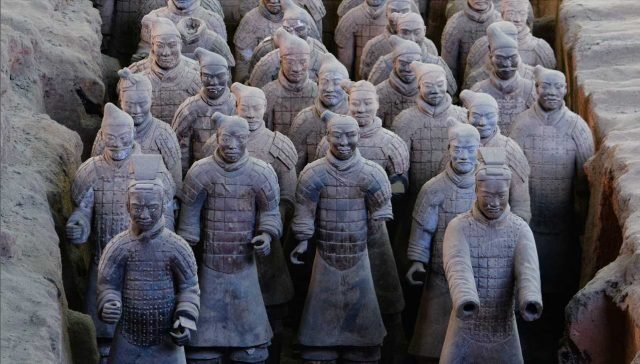Russia and China are Fostering Military Cooperation
by Petr Konovalov, …with New Eastern Outlook, Moscow, …and the Institute of Oriental Studies of the Russian Academy of Sciences, a research institution for the study of the countries and cultures of Asia and North Africa.
[ Editor’s Note: Trump’s trade war with China did have a realistic basis. Peking had officially pillaged US copyrighted and trademarked products for a long time. But that had always been overlooked, as China had opened itself up to large amounts of Western investments.
It had also been using a good chunk of its positive trade balance to buy US debt, which made the Treasury Department very happy. But that got soured when the US budget balances began running in the red, and China began building its US cash reserves, soon to be followed with building its gold reserves.
Back at Fort Knox in the US, no one can remember when a transparent audit of the US gold reserves has been done, to the point where most of the public today would not even know what Fort Knox used to be known for. More than a few suspect the gold holdings could be stored in a refrigerator.
China had a huge static army to defend itself from no one on the horizon that could even fantasize of a mainland invasion. As a major trading partner with the US, it saw no reason to spent huge sums on a combat navy, when that money could go into major infrastructure projects with long term domestic rewards.
Only when Uncle Sam began threatening that China had to be reigned in, meaning the US Navy would now be used to threaten its trading routes, did Peking realize it had to commit funding to a long term navy, and do the same with its antiquated airforce.
And last, when poking the Russian Bear came back into geo-political fashion, Putin had to do the same as China, divert development funds from business production infrastructure to modernize its antiquated military.
Meanwhile the US military complex woke up from its slumber, realizing that we could not pull hundreds of billions out of the US budget without some good old fashioned threats, so they rolled out their New Cold War effort, which has been most effective.
Congressmen have jumped with joy at the announcement of every new or updated US weapons system, and at the idea of building a huge navy to protect from no one that can threaten us with their own navy.
And yes, the orchestrated 9-11 fiasco, which VT has chronicled extensively, put the war lobby machine into overdrive, with major deficit funding that is still with us today.
Thus, in terms of a financial pummeling, the US has already lost the New Cold War, and guess who is stuck with the bill? Let me know what you think in the comments… Jim W. Dean ]
 Jim's Editor’s Notes are solely crowdfunded via PayPal
Jim's Editor’s Notes are solely crowdfunded via PayPal
Jim's work includes research, field trips, Heritage TV Legacy archiving & more. Thanks for helping. Click to donate >>

First published … January 04, 2021
At different times relations between Russia and China have evolved in different ways, but in recent years they have grown increasingly close, both against the backdrop of growing disagreements with the West and owing to the growing threat of international terrorism.
The problem of terrorism is particularly acute in Eurasia, and the fight against it requires uniting the efforts of the most powerful countries on the continent, and the political agenda involved requires that Russia and the PRC periodically remind the West about their power and independent positions. It is not surprising that not only economic and political cooperation, but also cooperation between militaries is gradually consolidating between the two countries.
In the field of security, Russia and China have long interacted within the bounds of the Shanghai Cooperation Organization (SCO), but military cooperation is not the main objective for the SCO. The two countries are bilaterally building up their cooperation in the field of defense.
The PRC buys military equipment from the Russian Federation at relatively low prices, and assimilates Russian technologies, taking them as the foundation to build its combat vehicles. Information is exchanged, and joint exercises are held.
Soon after US President Donald Trump came to power, a “trade war” began between the United States and China – something which seriously exacerbated US-Chinese relations. It comes as no surprise that against the background of the economic blows that Washington and Beijing exchanged throughout 2018, China’s military cooperation with Russia began to intensify swiftly.
In September 2018, the Chinese military took part in Russia’s largest military exercise since Soviet times, dubbed Vostok-2018.
On July 22, 2019 it became known that Russia and China were starting work on a new military cooperation agreement that would call for much broader, deeper interaction than the old agreement from 1993 did. On the very next day, July 23, 2019, the first joint air patrol conducted by Russian and Chinese strategic bombers took place.
Long-range aircraft capable of carrying regular missiles and nuclear weapons flew over the Sea of Japan, and approached the islands called the Liancourt Rocks (also Dokdo or Takeshima) – ones over which there is a territorial dispute between Japan and South Korea. Both countries were outraged, and declared that China and Russia had violated their airspace.
The Russian Federation and China both rejected the accusations, and stated that the flight was operated in strict accordance with international law.
However, it is quite possible that, while developing the route, Russia and China could have decided to lay it out so that it ran closer to the borders of Japan and South Korea, just to remind these countries about their military power. It is worth reiterating that Russia and Japan continue to have a territorial dispute over the Kuril Islands, while China and Japan are still arguing over the Senkaku Islands.
In addition, the issue involving the border between the PRC and South Korea has not yet been completely resolved. And finally, both Japan and South Korea are US allies, which also affects their relations with these Eurasian powers, and this makes periodic shows of force worthwhile.
The next day, on July 24, 2019, the PRC published its latest Defense White Paper. One of the important objectives for China that was stated in this document was fostering military cooperation with Russia, which, in Beijing’s opinion, is of great importance for the entire Asia-Pacific region (APR).
On December 22, 2020, the Russian Ministry of Defense reported that the Russian Aerospace Forces and the PRC Air Force had once again conducted joint patrols in APR airspace. Two Russian Tu-95MS strategic bombers and four Chinese H-6K strategic bombers flew together over the Sea of Japan and the East China Sea. The flight lasted more than 10 hours.
The report from the Russian Ministry of Defense emphasized that the patrolling activities were carried out without violating other countries’ airspace boundaries and in full compliance with international law, were not directed against other countries, and were consistent with the provisions contained in the Russian-Chinese plan for military cooperation for 2020.
Despite the transparency, lawfulness, and competent execution of the Russian-Chinese flight, some countries found reasons to complain anyway. For example, in certain sections along the route, the Russian-Chinese air group was accompanied by fighters from the Japanese Air Self-Defense Force.
Interestingly, on the same day, the media reported that a Russian fighter intercepted a Japanese patrol aircraft moving over neutral waters in the Sea of Japan, and the Sea of Okhotsk, toward the Russian national border: the aircraft was spotted on time, its crew was warned, there was no violation of the Russian airspace, and then the Japanese pilot on patrol returned to his homeland.
The next day, on December 23, 2020, the leadership in Japan announced to Russia and China that it was concerned about the overflight made by its bombers. According to Katsunobu Kato, the Japanese Chief Cabinet Secretary, his country did not receive any warning about the upcoming action, either from the Russian Federation or China, and was forced to urgently scramble its combat aircraft. Sure enough, Kato did not mention the incident with the Japanese patrol aircraft at all.
It is worth noting that the Russian-Chinese air group did not pose any real threat to Japan. It is common knowledge that during real hostilities these kinds of bombers make flights accompanied by fighter aircraft, and without that protection they are an easy target for enemy fighters.
Therefore, the very fact that the strategic bombers were traveling without any security proves that they were not heading off to fight, and that their flight was purely demonstrative.
Flights near rivals’ borders are periodically performed by all countries that have political disagreements with others (and, naturally, a suitable fleet of aircraft), and the path that leads from these demonstration flights to real armed conflicts is a very long one.
Reports about the appearance of foreign aircraft and ships along the Russian or Chinese borders regularly pop up in the media, and fortunately this has not led to anything serious so far.
Apparently, Japan will now also have to get used to the periodic appearance of Russian and Chinese combat vehicles at its borders, and likewise – the whole world – to news about Russian-Chinese military cooperation.
Petr Konovalov, a political observer, exclusively for the online magazine “New Eastern Outlook”.

Jim W. Dean is VT Editor Emeritus. He was an active editor on VT from 2010-2022. He was involved in operations, development, and writing, plus an active schedule of TV and radio interviews. He now writes and posts periodically for VT.
ATTENTION READERS
We See The World From All Sides and Want YOU To Be Fully InformedIn fact, intentional disinformation is a disgraceful scourge in media today. So to assuage any possible errant incorrect information posted herein, we strongly encourage you to seek corroboration from other non-VT sources before forming an educated opinion.
About VT - Policies & Disclosures - Comment Policy



